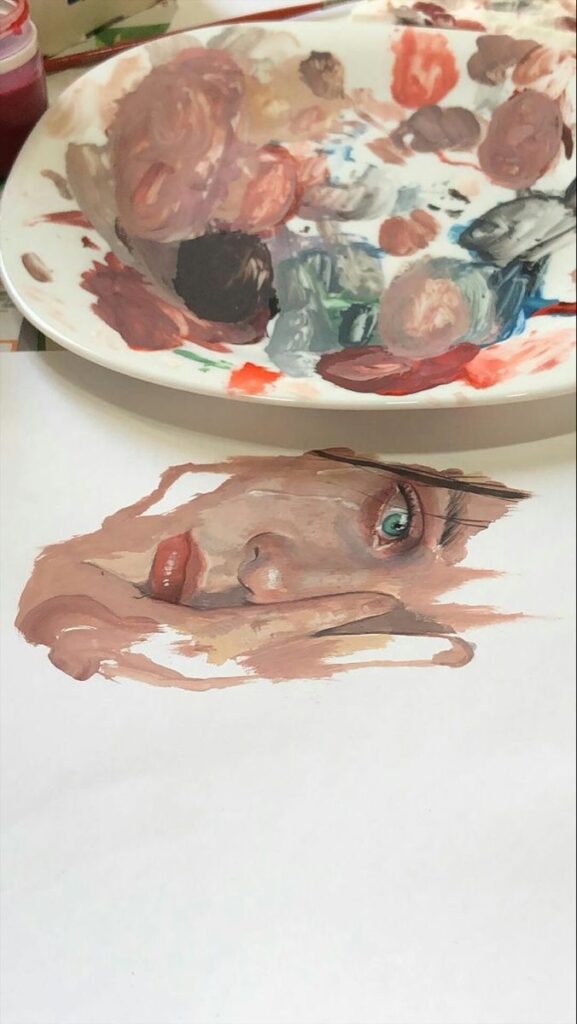This article will be a detailed guide for you to be able to pick the best art paint for beginners. And it will cover:
- Different existing art paints
- What to look for in your art paint of choice
- My best art paint recommendation for beginners
- Additional tips to get started in painting
Let’s get right into it.
What are the different art paints available in the market?
In a previous article, I mentioned the five most commonly used paints and talked in detail about each and every one. That list included acrylics, oil paint, watercolor, gouache, tempera, and encaustic. I encourage you to check out that article first if you have never read it, as it provides information about consistency, finish, durability, and the drying time of each art paint.
What should you look for in your art paint of choice?
To pick the best art paint for you as a beginner, you would have to take several factors into consideration. Mainly your personal preferences in terms of texture, finish, bendability, and durability. However, where you live is also a factor that artists often end up overlooking. Here’s a list of the main things to keep in mind before picking the appropriate art paint for you:
- Before we get started, I have to say that choosing your paint is a very personal task. Personal Preference and Experimentation matter the most, and nothing will ever beat trial and error. So you might as well consider experimenting with different types of art paints and brands to find what works best for your art style, techniques, and preferences.
- Health and Safety: For years, I have used acrylics because oil paint’s mediums just didn’t help my allergy. So to me, one of the primary factors in picking an art paint type is toxicity. Pay attention to the toxicity of the paint, especially if you’re working in a confined space without proper ventilation. Some paints, like oil paints, might require the use of solvents, which can emit harmful fumes.
How to paint in oils without using solvents? Is it even possible?
- Your budget: Quality paint can be expensive, but it’s an investment in your artwork and your art-making process. While budget paints can work for practice, using higher-quality paints helps you enjoy your sessions with less stress and yield more satisfying results.
- Surface Compatibility: Make sure the paint you choose is compatible with the surface you intend to paint on. Some paints work better on canvas, while others are suitable for paper, wood, or other materials.
- Brand and Reputation: Established art supply brands often have a reputation for producing consistent, high-quality products. Research reviews and recommendations from fellow artists to get an idea of what brands the art community trusts.
- Drying Time: The drying time of art paint can impact your art on many levels. Acrylics dry quickly, while oils have a longer drying time, allowing for more extended blending and layering. But if you live somewhere too humid or too dry, you might need to adapt your paint consistency and choice of solvents to help you either extend or reduce your art paint drying time.
- Opacity: Some paints are more opaque than others. This affects how layers of paint interact and whether underlying layers show through. Make sure you pick the right opacity for your technique.
- Quality and Pigment: Higher-quality paints generally contain more pigment, resulting in richer and more vibrant colors. Look for paints labeled as “artist” or “professional” grade for the best pigmentation.
Do I need to buy expensive art supplies to make great art?
Which art paint do I recommend to use as a beginner?
I know that as a beginner, you’ll need some guidance before you start experimenting and practicing with different supplies and art paint types.
And if you’re looking for a recommendation, I highly suggest you start with acrylics. Acrylics are simply the best art paint for beginners. It is the easiest of all and the least demanding. No solvents are required as it is water-based, and you can control the consistency and the drying time using only water. It is also non-toxic, can be used without ventilation, and the price is usually affordable.
These are some of my all-time favorite acrylic paint brands that you can get your hands on on Amazon.
ARTEZA Acrylic Paint, Set of 60 Colors:

Liquitex Professional Heavy Body Acrylic Paint, Classic 12

Winsor & Newton Galeria Acrylic Paint, 10

You can also opt for the option of buying individual tubes of paint and only getting primary colors, then proceeding with mixing your own set of different shades, which is what I personally do (you need to develop a strong color-mixing game, though).

Additional tips to get started with painting
Not every expensive art brand produces great-quality art paint. After you read reviews and see what other artists are using, choose the paint that resonates with you and aligns with your artistic vision the most. Your instinct is far better than any other factor.
Maybe consider buying a set. Along with paint, you’ll need brushes, a palette, a surface to paint on, and possibly additional materials like easels and mediums. A basic set of supplies could help you get started without feeling overwhelmed.
Look for paints labeled with high lightfastness ratings, especially if you plan to sell or display your artwork. Lightfastness indicates how well a paint resists fading over time when exposed to light.
Conclusion
Before you conclude the best art paint for beginners, take your time to explore and learn about different types of paint. As you gain more experience, you can always experiment with different paints to see what suits your style and preferences best. And what matters most is to enjoy creating <3




3 Comments